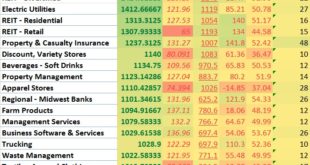Part 1 WoodShedder Time! Creating A Quantifiable Approach To Position Sizing
Part 2 Building A “Position System Simulator”
Part 3 Building Cover Sheet, Determining Probability of Results
Part 4 Adding To The Cover Sheet
Part 5: Setting Up The Calculations
It’s been awhile since I discussed my position size simulator or worked on it. Since it’s not as fresh in my mind, and I’ve been lacking in the sleep department, I am going to keep this post brief as I get back into the groove and do more writing about it than actual action.
This is what it looks like after I have added some variables. The highlighted yellow on the side for W1-W5,P1-P5 is just pulling data from another sheet if I want I can enter it in. Very simple calculations to determine the number of shares/contracts you can buy given the % capital per trade and starting account size. Very simple calculation on $ of capital towards trade. % of capital per trade times starting account size=$ of capital towards trade. $ of capital towards trade divided by share price or option price (for each full contract of 100) equals number of shares or contracts.
So set this up.
With this, we will be able to pull data and run calculations and ultimately determine based upon every individual possible combination that the 5 trades can go (based upon our given parameters of 5 possible outcomes per trade) what the amount of capital we will have after 5 trades based upon the position size and information given.
From there I believe we will be able to aggregate all the data and weight according to probability of each event happening, and then determine the probability of reaching certain criteria after 5 trades. Really we will have all the information we need to determine after X trades (multiple of 5) what the probability of certain criteria would be.
For example, the odds of 5 losses in a row can help determine the probability of 10 in a row by multiplying the odds. The odds of 10 “wins” in a row can be determined in a similar manner. If we have a duration of “trading career” that lasts say 150 trade periods (of one trade only unless we make significant adjustments), then you can determine what pace per 5 trades return you need to reach a certain goal and determine the percentage of series of 5 trades that are OVER that amount at a given bet percentage. And you can either maximize your probability of reaching that goal… Minimize your probability of getting a particular loss threshold… or a combination of achieving a minimum probability of reaching a certain threshold or more while still also limiting the probability of a particular 5trade long draw down to being under a certain threshold as well.
It’s important that you also understand the assumptions that this makes. It assumes that the data given is a correct accurate assessment. It also assumes that you have the psychological disposition to stick with the same system/bet size throughout many potential loss streaks you may run into. It also assumes you trade the system as effectively as the numbers dictate.
In reality, I think you can be reasonably confident that a strong possibility of it being a slightly “fatter tail” and fractal market and all that black swan stuff exists, but you still have a certain confidence that the data won’t deviate too strongly and I think you can still manage your risk and adapt your system as the feedback changes.
Some change systems based upon market conditions. That provides a better quality of sample size when evaluating systems, but to me is done on a lagging basis and won’t have a huge advantage since you are chasing the system that works in the given conditions, rather than anticipating it. Instead one might have capital allocated into trading different systems based upon the assessed probability of seeing that particular market type in the future.
At some point I want to get into an approach to the market I am developing that I consider most appropriate. But first I still will have to work on calculations that pull FROM this cover sheet for all the possible combinations of 5 trades. Then I will set about a sheet for a series of these 5 trades and a series of those 25 trades to construct expectations based upon 125 trades.
The next post will begin to set up the calculations sheet, which will do the bulk of the work.
If you enjoy the content at iBankCoin, please follow us on Twitter






excellent submit, very informative. I ponder why
the opposite specialists of this sector do not realize this.
You must continue your writing. I am confident, you have a great readers’ base already!